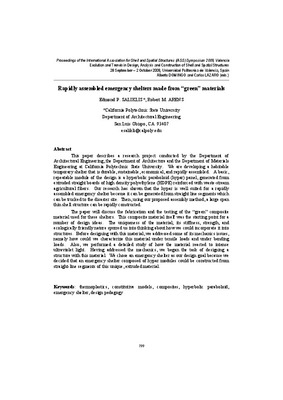JavaScript is disabled for your browser. Some features of this site may not work without it.
Buscar en RiuNet
Listar
Mi cuenta
Estadísticas
Ayuda RiuNet
Admin. UPV
Rapidly assemled emergency shelters made from "green" materials
Mostrar el registro sencillo del ítem
Ficheros en el ítem
| dc.contributor.author | SALIKLIS, Edmond P.
|
|
| dc.contributor.author | ARENS, Robert M.
|
|
| dc.contributor.editor | Domingo Cabo, Alberto
|
es_ES |
| dc.contributor.editor | Lázaro Fernández, Carlos Manuel
|
es_ES |
| dc.date.accessioned | 2010-01-26T12:40:38Z | |
| dc.date.available | 2010-01-26T12:40:38Z | |
| dc.date.issued | 2010-01-26T12:40:38Z | |
| dc.identifier.isbn | 978-84-8363-461-5 | |
| dc.identifier.uri | http://hdl.handle.net/10251/6946 | |
| dc.description | p. 799-812 | en_EN |
| dc.description.abstract | This paper describes a research project conducted by the Department of Architectural Engineering, the Department of Architecture and the Department of Materials Engineering at California Polytechnic State University. We are developing a habitable temporary shelter that is durable, sustainable, economical, and rapidly assembled. A basic, repeatable module of the design is a hyperbolic paraboloid (hypar) panel, generated from extruded straight boards of high density polyethylene (HDPE) reinforced with waste-stream agricultural fibers. Our research has shown that the hypar is well suited for a rapidly assembled emergency shelter because it can be generated from straight line segments which can be trucked to the disaster site. Then, using our proposed assembly method, a large span thin shell structure can be rapidly constructed. The paper will discuss the fabrication and the testing of the "green" composite material used for these shelters. This composite material itself was the starting point for a number of design ideas. The uniqueness of the material; its stiffness, strength, and ecologically friendly nature spurred us into thinking about how we could incorporate it into structures. Before designing with this material, we addressed some of its mechanics issues, namely how could we characterize this material under tensile loads and under bending loads. Also, we performed a detailed study of how the material reacted to intense ultraviolet light. Having addressed the mechanics, we began the task of designing a structure with this material. We chose an emergency shelter as our design goal because we decided that an emergency shelter composed of hypar modules could be constructed from straight-line segments of this unique, extruded material. | en_EN |
| dc.language | Inglés | en_EN |
| dc.publisher | Editorial Universitat Politècnica de València | es_ES |
| dc.relation.ispartof | Symposium of the International Association for Shell and Spatial Structures (50th. 2009. Valencia). Evolution and Trends in Design, Analysis and Construction of Shell and Spatial Structures : Proceedings | en_EN |
| dc.rights | Reserva de todos los derechos | en_EN |
| dc.subject | Thermoplastics | en_EN |
| dc.subject | Constitutive models | en_EN |
| dc.subject | Composites | en_EN |
| dc.subject | Hyperbolic paraboloid | en_EN |
| dc.subject | Emergency shelter | en_EN |
| dc.subject | Design pedagogy | en_EN |
| dc.title | Rapidly assemled emergency shelters made from "green" materials | en_EN |
| dc.type | Comunicación en congreso | en_EN |
| dc.rights.accessRights | Abierto | es_ES |
| dc.description.bibliographicCitation | Saliklis, EP.; Arens, RM. (2010). Rapidly assemled emergency shelters made from "green" materials. Editorial Universitat Politècnica de València. http://hdl.handle.net/10251/6946 | es_ES |
| dc.relation.conferencename | Symposium of the International Association for Shell and Spatial Structures | es_ES |
| dc.relation.conferencedate | 2009 | es_ES |
| dc.relation.conferenceplace | Valencia | es_ES |






